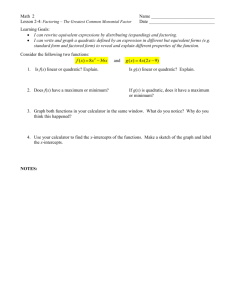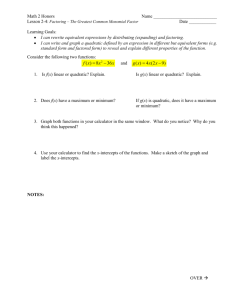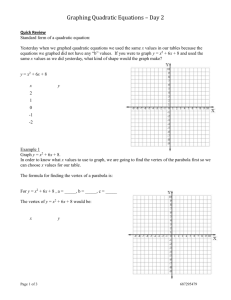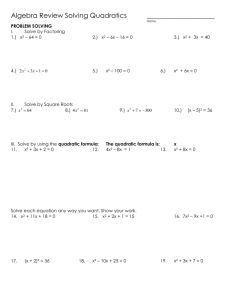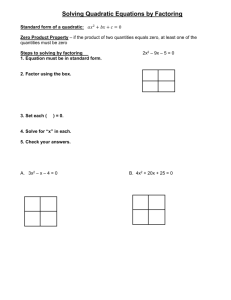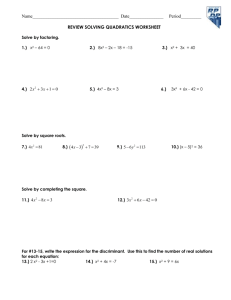3-1 Quadratic Functions Revisited
advertisement
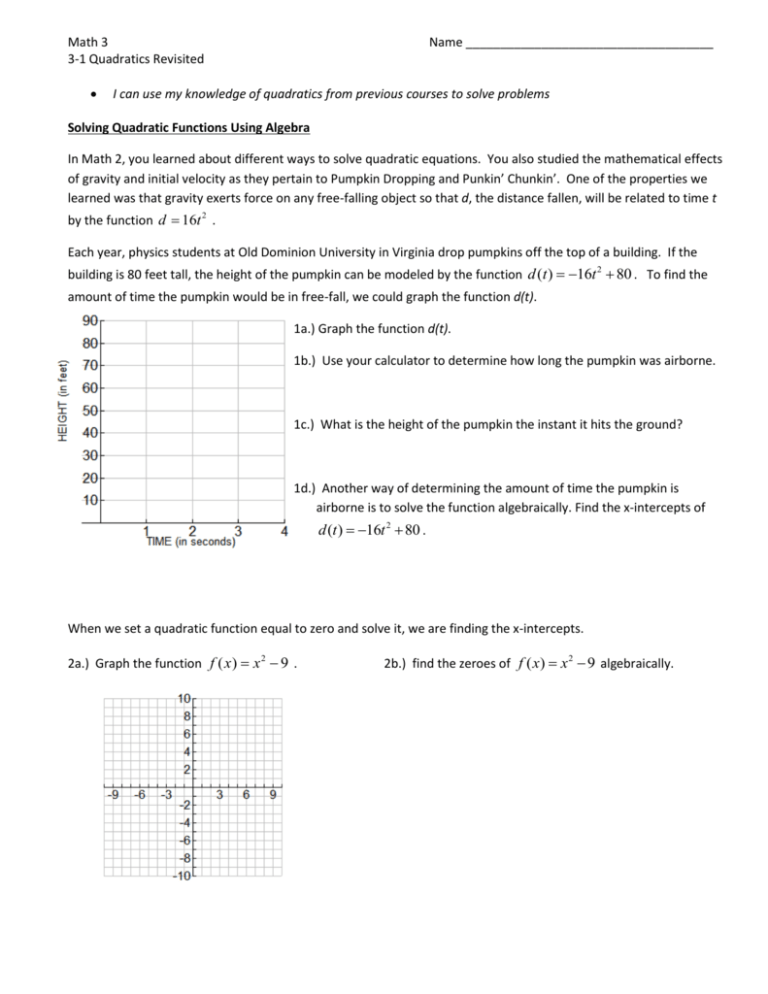
Math 3 3-1 Quadratics Revisited Name ____________________________________ I can use my knowledge of quadratics from previous courses to solve problems Solving Quadratic Functions Using Algebra In Math 2, you learned about different ways to solve quadratic equations. You also studied the mathematical effects of gravity and initial velocity as they pertain to Pumpkin Dropping and Punkin’ Chunkin’. One of the properties we learned was that gravity exerts force on any free-falling object so that d, the distance fallen, will be related to time t by the function d 16t 2 . Each year, physics students at Old Dominion University in Virginia drop pumpkins off the top of a building. If the building is 80 feet tall, the height of the pumpkin can be modeled by the function d (t ) 16t 2 80 . To find the amount of time the pumpkin would be in free-fall, we could graph the function d(t). 1a.) Graph the function d(t). 1b.) Use your calculator to determine how long the pumpkin was airborne. 1c.) What is the height of the pumpkin the instant it hits the ground? 1d.) Another way of determining the amount of time the pumpkin is airborne is to solve the function algebraically. Find the x-intercepts of d (t ) 16t 2 80 . When we set a quadratic function equal to zero and solve it, we are finding the x-intercepts. 2a.) Graph the function f ( x ) x 2 9 . 2b.) find the zeroes of f ( x) x 2 9 algebraically. Note: You do not need to factor a quadratic function that only has one term containing an x. We simply use algebra! Additional Examples: Find the x-intercepts for the functions below. Use algebra and check your solutions by graphing. 3a.) a( x) x 2 9 3b.) b( x) x 2 36 3c.) c( x) x 2 1 Solving Quadratic Functions by Factoring X-intercepts of functions are sometimes called zeroes or roots. If your simplified quadratic function contains two terms with x’s it might be possible to find the x-intercepts by factoring and applying the Zero Product Property. The Zero Product Property states that if the product of any two quantities is zero, then one of the two quantities must equal zero If A B 0, then either A 0 or B 0 The key to solving quadratic functions using factoring is to set quadratic equal to zero, factor, set the factors equal to zero, and then solve your equations. Example: Find the x-intercepts of f ( x) x 2 2 x 8 by factoring. Check to be sure your zeroes are correct by graphing on your calculator. Additional Practice: Find the zeroes (also known as x-intercepts or roots) by factoring. Check your answers on your calculator by graphing. 4a.) d ( x) x 2 10 x 24 4b.) h( x) x 2 2 x 15 4c.) j ( x) x 2 7 x 18 Sometimes it is necessary or useful to common factor to find x-intercepts. Example: Find the x-intercepts for: f ( x) x 2 4 x Additional Practice: Find the roots (also known as x-intercepts) for the functions below. 5a.) k ( x) x 2 3x 5b.) l ( x) 2 x 2 4 x Example: f ( x) 15x 2 27 x 6 Additonal Practice: 6a.) m( x) 30 x 2 200 x 70 6b.) n( x) 350 x 2 250 x 100 Solving Quadratic Functions using The Quadratic Formula When factoring becomes too difficult or is not possible, another way to find x-intercepts is by using the Quadratic Formula. The Quadratic Formula is: For quadratic functions in the form ax 2 bx c 0 , x b b2 4ac 2a 2a Find the zeroes using the Quadratic Formula. Graph it on your calculator to check your solution. 7a.) q( x) x 2 2 x 8 (try not to use a calculator here) 7b.) r ( x) x 2 5x 3 7c.) s( x) 3x 2 16 x 18 7d.) t ( x) 2 x 2 7 x 9 7e.) What was unique about the solutions to (7d)? What was unique about the graph of (7d)? Imaginary Numbers In Math 2, you learned about a new set of numbers: the imaginary numbers. The square root of a negative yields an imaginary solution. The basis for this was 1 i . Therefore, 16 4i , because 16 16 1 4i . Simplify the following. 25 ______ 9 ______ 64 ______ 28 ______ 576 ______ 8a.) Find the x-intercepts using the Quadratic Formula: f ( x) x 2 6 x 13 8b.) What can you determine without using a calculator for the graph of f ( x ) above using only the equation and your work from (8a) above.
